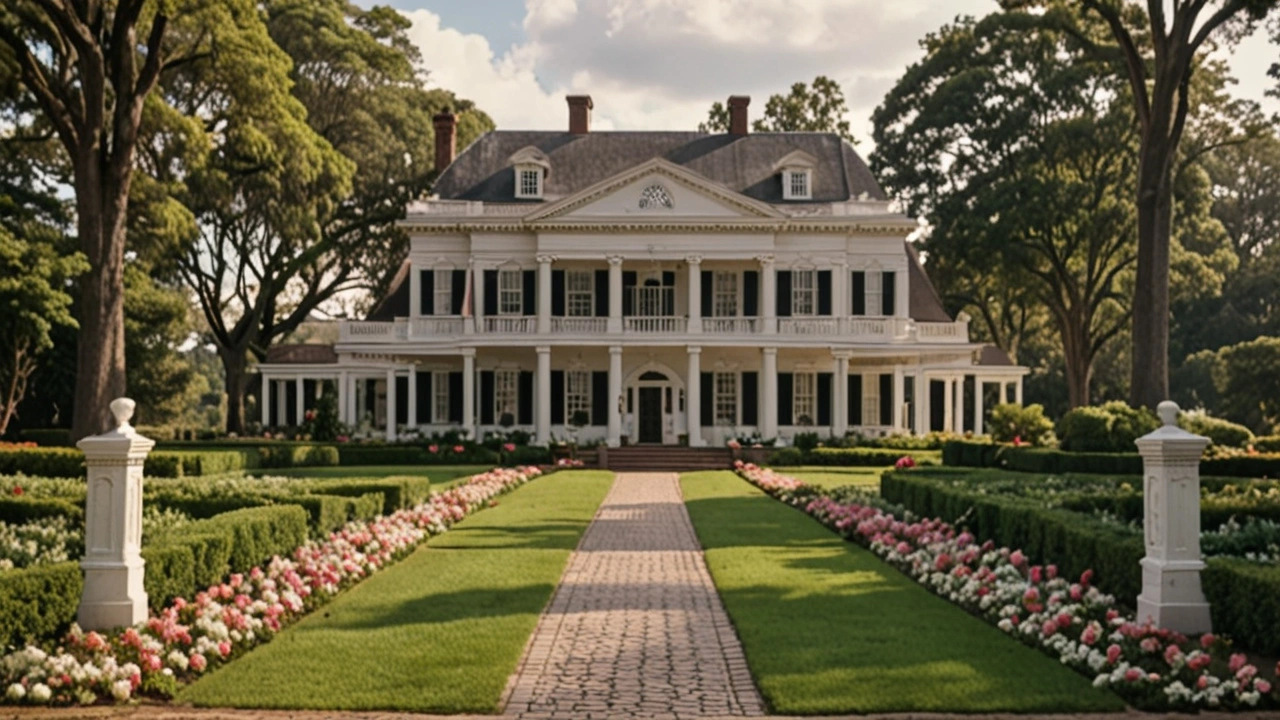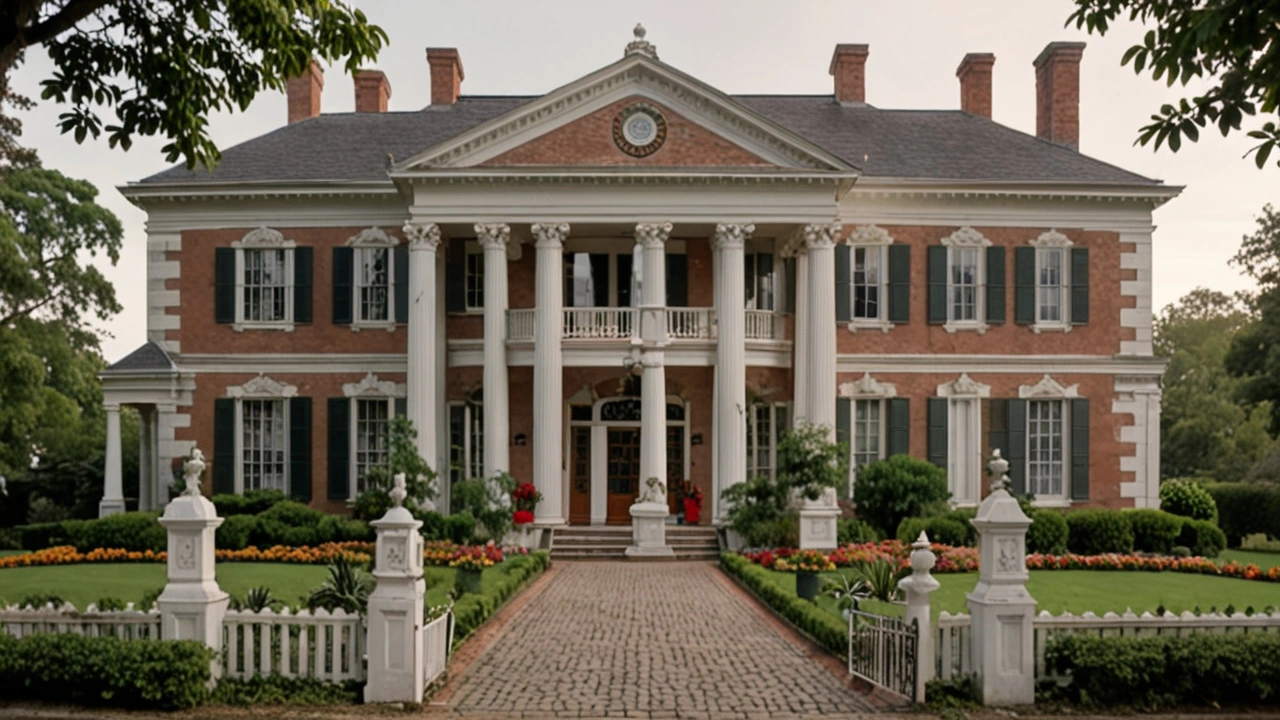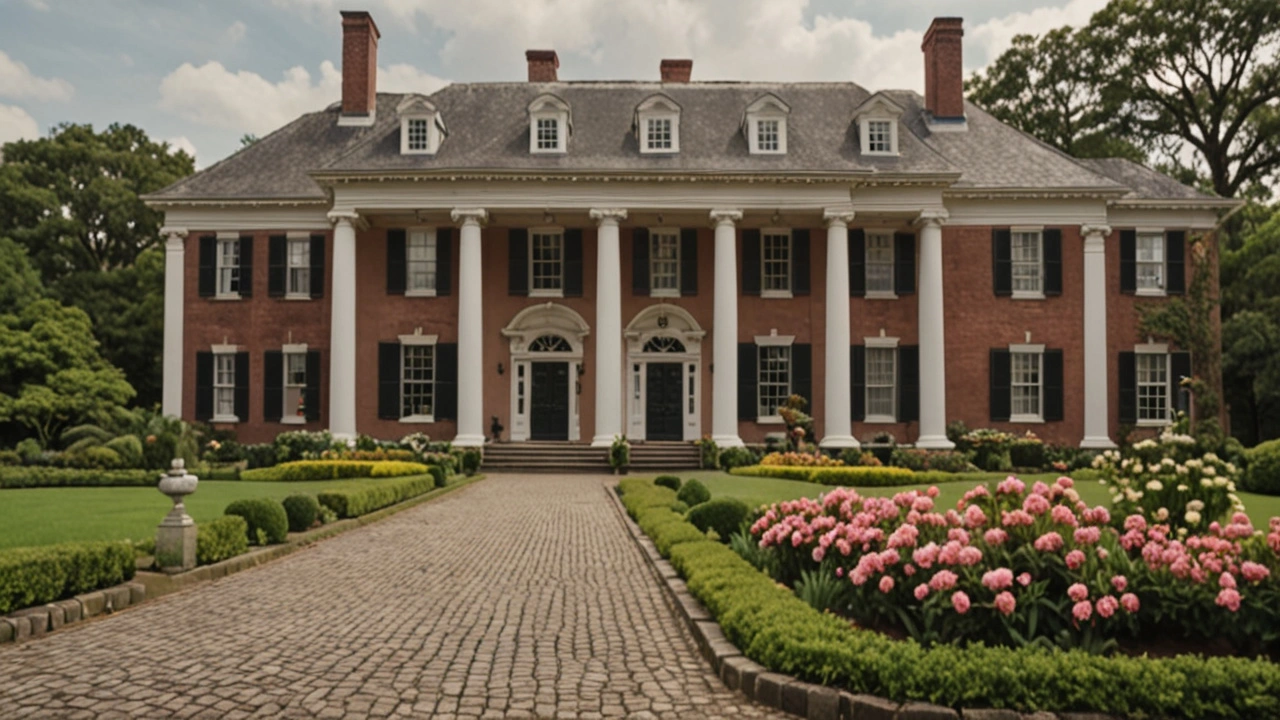Exploring the Timeless Beauty of Colonial Architecture: An Homage to Historic Masterpieces
 Jul, 13 2024
Jul, 13 2024
Colonial architecture is more than just a style; it's a journey through history encapsulating the spirit and culture of a bygone era. This architectural genre, characterized by its symmetry, geometric simplicity, and robust construction, offers a fascinating glimpse into the past.
The roots of colonial architecture trace back to the colonial powers that established their settlements in new lands, each bringing their unique styles, adapted to new environments and materials. From the stately manor homes of the American colonies to the intricate designs of the Spanish missions, each structure tells a rich story of its origins and evolution.
Walking through neighborhoods adorned with colonial buildings, one can't help but notice the distinct features such as pitched roofs, elaborate doorways, and large, evenly spaced windows. These elements not only reflect the aesthetics of the time but also the practical solutions to climate and lifestyle needs.
You'll find significant examples of colonial architecture in countries all over the world, each reflecting a blend of native and foreign influences. Whether it's the charming Georgian homes in the US or the majestic colonial buildings in India, these structures continue to draw admiration and inspire contemporary designs.
Preserving these historical masterpieces involves understanding their unique construction techniques and materials. Modern adaptations often integrate these timeless features with new technologies, ensuring these architectural gems retain their relevance and grandeur for future generations.
- Defining Colonial Architecture
- Historical Influences
- Key Architectural Elements
- Noteworthy Examples Around the World
- Preservation and Modern Adaptations
Defining Colonial Architecture
Colonial architecture refers to the architectural style that emerged during the period of colonialism, typically spanning from the 16th to the early 19th century. This style was brought to new territories by European settlers, who adapted their traditional designs to the new environments they encountered. While the overall aesthetic of the buildings retains a certain Old-World charm, it also displays a unique blend of local materials and influences.
The essence of colonial architecture can be seen in its simplicity and symmetry. Structures often feature evenly spaced windows, steep gable roofs, and a centered front door. The interiors are marked by spacious rooms and high ceilings, which not only showcased elegance but also provided better ventilation. Primarily built with locally available materials such as wood, brick, and stone, these buildings were designed to be both sturdy and adaptable to diverse climates.
The influence of various mother countries is evident in different colonized regions. For instance, British colonial architecture in the Americas is characterized by the Georgian style, noted for its refined proportions and classical details. In contrast, Spanish colonial architecture found in parts of Latin America showcases elaborate decorations, courtyards, and heavy use of stucco and tile.
One cannot discuss colonial architecture without mentioning the Dutch colonial influence seen in places like New York. These homes are easily recognizable by their gambrel roofs and flared eaves, which were both functional and attractive. French colonial architecture, represented by the wooden Creole cottages in Louisiana, features wide porches and raised basements to combat flooding and heat.
"Colonial architecture is a testament to the resilience and ingenuity of settlers who melded old-world styles with new-world challenges,” states architectural historian John R. Stilgoe.
Interestingly, the design principles of colonial architecture were also often driven by practicality. Many colonial homes had large, central fireplaces, which served as the main source of heating during harsh winters. Rooms were arranged to maximize efficiency and comfort, often mirroring the hierarchical social structure of the time.
In modern times, colonial architecture continues to be celebrated for its timeless beauty and historical significance. Many homeowners and preservationists strive to maintain and restore these buildings to their original grandeur. This requires an in-depth understanding of traditional building techniques and materials, as well as a commitment to preserving historical integrity while incorporating modern conveniences.
Colonial architecture not only offers us a glimpse into the past but also serves as an enduring influence on contemporary design. Whether you’re strolling through the streets of historic Boston or exploring the vibrant quarters of old Manila, the lasting impact of this architectural style is undeniably profound.
Historical Influences
Colonial architecture's origins are deeply intertwined with the histories of various colonial powers and their expansions across the globe. As Spanish, French, English, Dutch, and Portuguese settlers established colonies, each brought their distinct architectural styles, which amalgamated with local traditions and environments to create unique, enduring designs.
The Spanish influence, for example, is predominant in the architecture found throughout Latin America, from Mexico down to Argentina. Known for their exuberant baroque style, the Spanish introduced features such as arched courtyards, stucco walls, and red-tiled roofs. Moorish influence is evident in intricate tile work and elaborate iron grilles. One of the most famous examples is the Misiones in Paraguay, which bears witness to the blend of local and European techniques.
In North America, English settlers crafted what we now refer to as the Colonial Georgian style. The Georgian style is characterized by its symmetry, formal layout, and the prevalence of sash windows and paneled doors. This style was a reflection of contemporary English tastes, imitating the classical proportions and elements of Renaissance Italy filtered through British interpretation. Mount Vernon, the residence of George Washington, stands as an iconic example of this style.
French colonial architecture is another significant influence, especially seen in Louisiana and the Caribbean. French settlers brought with them traits from their own architectural traditions, such as raised basements to combat dampness and steeply pitched roofs designed to shed heavy rainfall. One of the defining features includes the broad, wrap-around verandas that are so characteristic of the French Quarter in New Orleans.
Dutch colonial architecture offers yet another variation, prominently found in New York and New Jersey. These structures are noted for their distinct gambrel roofs, which provide a full second floor of living space. Thick stone walls and double-hung sash windows are other features introduced by the Dutch, many of which can be seen in the historic homes of Albany, New York.
Understanding these varied influences offers insight into the adaptability and resilience of colonial architecture. The settlers were resourceful, blending their heritage with local materials and climatic conditions. These adaptive methods created buildings that were both beautiful and functional. For instance, many colonial homes included large central chimneys, which served both as a practical heating solution and a central, organizing feature of the house.
"Colonial architecture represents the marriage of necessity and artistry. Its enduring appeal lies in its ability to blend the old with the new, creating spaces that are timeless in their charm and functional in their design." — Architectural historian Dr. Emily Green
Indeed, the historical influences on colonial architecture are a testament to both the ingenuity of early settlers and the enduring appeal of classic designs. By understanding these roots, we can appreciate the diversity and adaptive nature of this architectural style, and ensure its preservation for future generations to admire.

Key Architectural Elements
Colonial architecture is known for certain defining characteristics that set it apart from other styles. One of the most notable features is its symmetry. Colonial buildings often have a balanced, pleasing proportion where each side mirrors the other. This symmetry extends to window placement, doors, and even the layout of rooms inside the home.
You often see pitched roofs in colonial structures, designed to accommodate heavy rain or snow. These roofs are usually steep, making them practical for various weather conditions while also adding to the aesthetic appeal. In some designs, there may also be dormers, which are small, vertical windows projecting from the slope of the roof, adding both light and space to upper floors.
The doorways in colonial architecture are usually grand and ornate, often serving as the focal point of the facade. The entrance is typically framed by sidelights and transoms that allow natural light to filter into the foyer. Heavy, wooden doors are common, sometimes accented with brass or iron fixtures, giving a robust, welcoming impression.
Windows are another important aspect. They are generally large and evenly spaced, often configured in double-hung sashes with small panes. These windows not only enhance the building's symmetry but also provide ample light and ventilation, which was crucial before the advent of modern heating and cooling systems.
Brick and wood are the primary materials used in colonial architecture. Bricks are usually red or brown, providing a warm, earthy tone to the buildings. Wooden elements like clapboards or shingles add texture and can be painted in various colors. These materials were chosen for their availability and durability, making the structures long-lasting.
“Colonial architecture has a timeless quality, blending form and function in a way that remains relevant even today.” – John Waters, Architectural Historian
One can't overlook the interiors, which frequently feature fireplaces as central elements in living spaces. During colonial times, fireplaces were necessary for heating and cooking. They often boast detailed mantels and hearths, contributing to the room's character and charm.
Another element worth mentioning is the central chimney, a hallmark in many colonial homes. These chimneys are not only functional, directing smoke from fireplaces out of the house, but they also serve as a structural spine around which rooms are organized, providing stability and warmth throughout the building.
Architectural Details
The attention to detail in colonial architecture is one of its most charming aspects. You will often find intricate woodworking, including crown moldings, wainscoting, and chair rails, which add a touch of elegance to the interiors. In many homes, there are built-in cupboards and shelves, designed both for practicality and aesthetics.The use of color in colonial architecture is deliberate and tasteful. Exteriors often feature muted, earthy tones while interiors may utilize a broader palette, including colors like rich blues, greens, and yellows, which were popular during the colonial period.
If you are inspired by colonial architecture and considering incorporating its elements into your home, focus on these key features. Authenticity in materials and proportions will help maintain the style's integrity, ensuring your space feels both timeless and historically rich.
Noteworthy Examples Around the World
Colonial architecture has left a distinct mark on various countries around the globe. Each structure stands as a testament to the blending of native cultures and foreign influences, resulting in unique and stunning architectural masterpieces.
Starting with the United States, the East Coast is littered with Georgian-style homes and plantation houses that harken back to the 18th century. These homes are characterized by their symmetry, classic columns, and detailed brickwork. One such example is the renowned Mount Vernon, the home of George Washington. This iconic estate showcases the elegant simplicity and commanding presence typical of colonial architecture. The sweeping lawns and expansive views make it not just a historical site, but also a picturesque landmark.
In the Caribbean, the Spanish and French colonial influences can be vividly seen. The city of Havana, Cuba, is a living museum of colonial architecture. Here, you can find a mixture of Moorish, Baroque, and Neoclassical design elements in colorful, ornate buildings that have stood the test of time. Walking through Old Havana feels like stepping into a different era altogether.
Meanwhile, in India, the British colonial era brought forth a fusion of Victorian and traditional Indian elements. The Victoria Memorial in Kolkata is a notable example, designed to commemorate Queen Victoria's 25 years of rule over India. This marble edifice, with its grand dome and stately colonnades, ranks high among colonial architectural marvels. The lush gardens surrounding the memorial add to its historical and aesthetic appeal.
Australia’s colonial era also produced some magnificent structures. In Sydney, the Hyde Park Barracks stand as a symbol of the country's early convict history. Built by convicts in the early 19th century, this building has recently been transformed into a museum, providing visitors a glimpse into the lives of those who built and inhabited it. Its simple, yet elegant Georgian design is undeniably classic and timeless.
"Architecture should speak of its time and place, but yearn for timelessness." - Frank Gehry
In the Philippines, the Spanish colonial era left behind numerous beautiful churches and grand houses. The city of Vigan is particularly notable for its well-preserved colonial buildings. Calle Crisologo, a cobblestone street lined with ancestral houses, transports visitors to a different time. The fusion of traditional Filipino design elements with Spanish flair is a sight to behold.
Finally, South Africa's Cape Dutch colonial architecture offers an elegant blend of Dutch, German, and French influences. The town of Stellenbosch boasts many fine examples of Cape Dutch houses, characterized by their distinctive whitewashed walls and ornate gables. These buildings, set against the backdrop of rolling vineyards, create a picturesque landscape that captures the essence of colonial elegance.
Exploring these noteworthy examples of colonial architecture around the world not only helps us appreciate the aesthetic qualities of these structures but also provides a deeper understanding of the historical contexts that shaped them. As these timeless buildings continue to captivate and inspire, their preservation and adaptation ensure they remain relevant in modern times.

Preservation and Modern Adaptations
Preserving colonial architecture is both an art and a science. These historical buildings are not just structures; they are testimonies of a unique cultural heritage. The key to preservation lies in understanding the original materials and techniques used in construction. For instance, many colonial buildings were made using handmade bricks, wood from local trees, and natural lime mortar. Knowing this, restoration experts can make informed choices on how to maintain these structures while preserving their original charm.
One effective approach to preservation is through adaptive reuse. This means repurposing old colonial buildings for modern use while keeping their historical elements intact. For example, an old colonial mansion might be converted into a boutique hotel or a community center. This not only breathes new life into the building but also makes it relevant for contemporary needs.
"Preserving our historic buildings is essential to maintaining our cultural and architectural identity," says Sarah Williams, a renowned conservation architect. "Adaptive reuse offers a sustainable way to keep these structures functional and appreciated."
Modern adaptations of colonial architecture often focus on incorporating modern conveniences without disrupting the aesthetic harmony. This might involve discreetly installing modern plumbing and electrical systems, or using climate control solutions that do not alter the building's facade. In tropical areas, this can mean using energy-efficient windows that blend seamlessly with the original design to provide comfort without compromising the building's historic look.
Another crucial aspect is public engagement and community support. Preservation initiatives often thrive on community involvement, which fosters a sense of collective responsibility towards safeguarding these historic treasures. Local heritage organizations play a significant role in educating the public and advocating for the importance of these structures.
Challenges in Preservation
Preservation is not without its challenges. One common hurdle is the availability of skilled labor familiar with traditional construction techniques. Finding craftsmen who can work with materials like lime mortar or hand-split shingles is becoming increasingly rare. Additionally, funding for preservation projects can be limited, often requiring grants, donations, or government support to carry out necessary work.
It's also important to strike a balance between preserving the past and allowing for contemporary needs. In some cases, stringent preservation laws can restrict necessary modifications, making it challenging to adapt these buildings for modern uses. This is why flexible regulations and thoughtful planning are crucial.
Technology's Role
Tech advancements have started to play an essential role in preservation. Digital documentation, like 3D scanning, helps create precise records of the existing conditions of colonial buildings. This data can be invaluable in planning restoration projects, ensuring accuracy, and minimizing errors. Additionally, data collected can help create virtual tours, allowing a broader audience to appreciate these architectural marvels without physically being present.
Preserving colonial architecture is about more than just saving old buildings; it’s about maintaining a tangible connection to history. By thoughtfully integrating modern adaptations, we can enjoy the beauty and significance of these structures for many years to come. Whether through careful restoration or adaptive reuse, each project underscores the enduring relevance of these historical gems in contemporary settings.